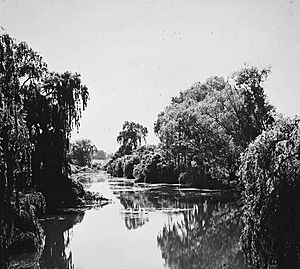Molonglo Plain facts for kids
The Molonglo Plain is a flat area of land, also known as a flood plain. It is found along the Molonglo River. The most well-known part is in the Australian Capital Territory. This area was flooded in the 1960s to create Lake Burley Griffin.
The Molonglo Plain is one of four main plains where the city of Canberra is built. The other plains are the Ginninderra Plain, the Limestone Plain, and the Tuggeranong Plain. The term "Molonglo Plains" can also mean all the flood plains along the entire Molonglo River. This includes areas near Queanbeyan. The upper part of the plain is sometimes called the Hoskinstown Plain. It is surrounded by hills like the Turallo Range. This area is also famous as the birthplace of cricket and Australian rules football pioneer Tom Wills.
Upper Molonglo Plain
The Upper Molonglo Plain was home to some very successful farms. These farms were called 'Gidleigh', 'Foxlow', 'Carwoola', and 'Primrose Valley'. They were important for the Queanbeyan district. The 'Foxlow' farm was started by HC Antill. Later, it was given to J Hoskins, who the village of Hoskinstown is named after.
Lower Molonglo Plain
Before Lake Burley Griffin was built, the Lower Molonglo Plain had very rich soil. This made it one of the best farming areas near Canberra. John Joshua Moore was one of the first farmers to use land where Canberra now stands. He set up a small outpost with an overseer and some convict workers. His land included areas where the hospital, Civic Centre, and the Australian National University are today. It also covered parts of the Molonglo Plain.
In 1843, during a tough economic time, Moore sold his land. It was bought by Lieutenant Arthur Jeffreys, who was related to Robert Campbell.
Old Buildings of the Plain
Only one original building from the Molonglo Plain remains today. It is called 'Blundells Cottage'. It was built in 1858 by George Campbell, Robert Campbell's son. It was made for his ploughman, William Ginn. The cottage was built on higher ground to avoid floods. It is about 400 metres north of the Molonglo River.
Many other old buildings on or near the Molonglo Plain are now gone. They were removed as Canberra grew over the last 70 years. One impressive building was the Klensendorlffe villa. This was a large stone house with ten rooms. It stood near where Albert Hall is today until the mid-1920s. The Acton homestead was another important building. It was built around 1843 by Lieutenant Arthur Jeffreys. This homestead lasted until 1941. It was then taken down to make space for the Canberra Community Hospital.
River Flow Changes
Flood plains need regular floods to stay healthy. Floods bring new soil and nutrients from the water onto the plain. This helps the land stay fertile.
The Googong Dam was built in 1979. It is on the Queanbeyan River, about 5 kilometres upstream from Queanbeyan. This dam helps control how much water flows in the river. It affects the Molonglo River after the two rivers join. The Lower Molonglo River had its last big flood in 1971.


